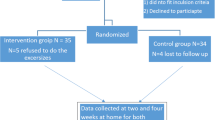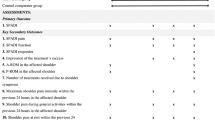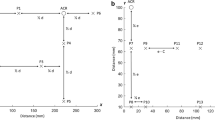Abstract
Breast screening programmes have facilitated more conservative approaches to the surgical and radiotherapy management of women diagnosed with breast cancer. This study investigated changes in shoulder movement after surgery for primary, operable breast cancer to determine the effect of elective physiotherapy intervention. Sixty-five women were randomly assigned to either the treatment (TG) or control group (CG) and assessments were completed preoperatively, at day 5 and at 1 month, 3, 6, 12 and 24 months postoperatively. The CG only received an exercise instruction booklet in comparison to the TG who received the Physiotherapy Management Care Plan (PMCP). Analyses of variance revealed that abduction returned to preoperative levels more quickly in the TG than in the CG. The TG women had 14° more abduction at 3 months and 7° at 24 months. Functional recovery at 1 month was greater in those randomised to the TG, with a dominant operated arm (OA) or receiving breast-conserving surgery. However, it was not possible to predict recovery over the 2 years postoperatively on the basis of an individual woman's recovery at 1 month postoperatively. The eventual recovery of abduction or flexion range of movement was not related to the dominance of the OA nor to the surgical procedure performed. The PMCP provided in the early postoperative period is effective in facilitating and maintaining the recovery of shoulder movement over the first 2 years after breast cancer surgery.
Similar content being viewed by others
References
Forrest APM, Roberts MM, Preece P, Henk JM, Campbell H, Hughes LE, Desai S, Hulbert M: The Cardiff-St Mary's trial. Brit J Surg 61 766–769, 1974
Nikkanen TAV, Vanharanta H, Helenius-Reunanen H: Swelling of the upper extremity, function and muscle strength of the shoulder joint following mastectomy combined with radiotherapy. Ann Clin Res 10 273–279, 1978
Ryttov N, Holm N, Qvist N, Blichert-Toft M: Influence of adjuvant irradiation on the development of late arm lymphoedema and impaired shoulder mobility after mastectomy for carcinoma of the breast. Acta Oncol 27(6a) 667–670, 1988
Hladiuk M, Huchcroft S, Temple W, Schurr BE: Arm function after axillary dissection for breast cancer: a pilot study to provide parameter estimates. J Surg Oncol 50: 47–52, 1992
Keramopoulos A, Tsionou C, Minaretzis D, Michalas S, Aravantinos D: Arm morbidity following treatment of breast cancer with total axillary dissection: a multivariate approach. Oncology 50 445–449, 1993
Maunsell E, Brisson J, Deschenes L: Arm problems and psychological distress after surgery for breast cancer. Can J Surg 36(4) 315–320, 1993
Spratt JS, Donegan WL: Surgical management. In: Donegan WL, Spratt JS (eds) Cancer of the Breast. 4th edn, WB Saunders, Philadelphia, 1995, pp 443–504
Sleigh C: Physiotherapy and breast cancer. In: Denton S (ed) Breast Cancer Nursing. 1st edn, Chapman and Hall, London, 1996, pp 186–203
Box RC: Rehabilitation after breast cancer. In: Sapsford R, Bullock-Saxton J, Markwell S (eds) Women's Health: A Text-book for Physiotherapists. WB Saunders, London, 1998, pp 454–465.
Bassey E, Morgan K, Dallosso H, Ebrahim S: Flexibility of the shoulder joint measured as range of abduction in a large representative sample of men and women over 65 years of age. Eur J App Physio 58 353–360, 1989
Chakravarty K, Webley M: Shoulder joint movement and its relationship to disability in the elderly. J Rheum 20: 1359–1361, 1993
Badley EM, Wagstaff S, Wood PHN: Measures of functional ability (disability) in arthritis in relation to impairment of range of joint movement. Annal Rheum Dis 43 563–569, 1984
Landis SH, Murray T, Bolden S, Wingo PA: Cancer statistics, 1998. CA–Cancer J Clin 48(1): 6–29, 1998
Flew T: Wound drainage following radical mastectomy: the effect of restriction of shoulder movement. Brit J Surg 66: 302–305, 1979
Lotze M, Duncan M, Gerber L, Woltering E, Rosenberg S: Early versus delayed shoulder motion following axillary dissection. Annal Surg 193(3) 288–295, 1981
Dawson I, Stam L, Heslinga J, Kalsbeek H: Effect of shoulder immobilisation on wound seroma and shoulder dysfunction following modified radical mastectomy: a randomised prospective clinical trial. Brit J Surg 76(3) 311–312, 1989
Ryttov N, Blichert-Toft M, Madsen E, Weber J: Influence of adjuvant irradiation on shoulder joint function after mastectomy for breast carcinoma. Acta Radiol Onc 22: 29–33, 1983
Box R, Reul-Hirche H: Results of a quality improvement project evaluating a physiotherapy programme for women after breast cancer surgery (abstract). Proc Nat Congress of the Australian Physiotherapy Association, Brisbane, July 14–19, 1996, Australian Physiotherapy Association, Melbourne, 1996, pp 86–87
Box RC, Reul-Hirche HM, Bullock-Saxton JE, Furnival CM: Physiotherapy after breast cancer surgery: results of a ran-domised controlled study to minimise lymphoedema. Breast Cancer Res Treat 75: 51–64.
Box RC: The evaluation of a physiotherapy management care plan for women undergoing breast cancer surgery. PhD Thesis, Physiotherapy Department, University of Queensland, 2000.
Wingate L: Efficacy of physical therapy for patients who have undergone mastectomies: a prospective study. Phys Ther 65(6) 896–900, 1985
Wingate L, Croghan I, Natarjan N, Michalek A, Jordan C: Rehabilitation of the mastectomy patient: a randomised, blind prospective study. Arch Phys Med Rehab 70(1): 21–24, 1989
Gerber L, Lampert M, Wood C, Duncan M, D'Angelo T, Schain W, McDonald H, Danforth D, Findlay P, Glatstein E, Lippman M, Steinberg S, Gorrell C, Lichter A, Demoss E: Comparison of pain, motion and edema after modified radical mastectomy vs local excision with axillary dissection and radiotherapy. Breast Cancer Res Treat 21 139–145, 1992
Gutman H, Kersz T, Barzilai T, Haddad M, Reiss R: Achievements of physical therapy in patients after modified radical mastectomy compared with quadrantectomy, axillary dissection and radiation for carcinoma of the breast. Arch Surg 125: 389–391, 1990
Tabachnick BG, Fidell LS: Using Multivariate Statistics. 3rd edn, HarperCollins College Publishers, New York, 1996
Shah BV, Barnwell BG, Bieler GS: The MULTILOG procedure. In: SUDAAN User's Manual, Release 7.5. Research Triangle Park, Research Triangle Institute, NC, 1997, Section 11.1–11.3
Author information
Authors and Affiliations
Rights and permissions
About this article
Cite this article
Box, R.C., Reul-Hirche, H.M., Bullock-Saxton, J.E. et al. Shoulder Movement After Breast Cancer Surgery: Results of a Randomised Controlled Study of Postoperative Physiotherapy. Breast Cancer Res Treat 75, 35–50 (2002). https://doi.org/10.1023/A:1016571204924
Issue Date:
DOI: https://doi.org/10.1023/A:1016571204924




